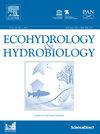Biogeochemical and microbial community structure differently modulates CO2 and CH4 dynamics in two adjacent volcanic lakes (Monticchio, Italy)
IF 2.2
4区 环境科学与生态学
Q2 ECOLOGY
引用次数: 0
Abstract
By hosting significant amounts of extra-atmospheric dissolved gases, including geogenic CO2 and CH4, volcanic lakes provide relevant ecosystem services through the key role the aquatic microbial community in mediating freshwater carbon fluxes. In view of elucidating the mechanisms governing the microbial spatial distribution and the possible implications for ecosystem functioning, we compared the hydrogeochemical features and the microbial community structure of two adjacent stratified volcanic lakes (Lake Grande - LG and Lake Piccolo - LP). Water chemistry, gases and their isotopic composition were coupled with microbial pigment profiling, cell counting, and phylogenetic analyses. LP showed transparent waters with low concentrations of chlorophyll-a and the occurrence of phycoerytrin-rich cyanobacteria. LG was relatively more eutrophic with a higher occurrence of diatoms and phycocyanine-rich cyanobacteria. Considering the higher concentrations of CO2 and CH4 in bottom waters, the oligotrophic LP was likely a more efficient sink of geogenic CO2 in comparison to the adjacent eutrophic LG. The prokaryotic community was dominated by the mixothrophic hgcI clade (family Sporichthyaceae) in the LG surface waters, while in LP this taxon was dominant down to -15 m. Moreover, in LP, the bottom dark waters harbored a unique strictly anaerobic bacterial assemblage associated with methanogenic Archaea (i.e. Methanomicrobiales), resulting in a high biogenic methane concentration. Water layering and light penetration were confirmed as major factors affecting the microbial distribution patterns. The observed differences in the geochemical and trophic conditions reflected the structure of the aquatic microbial community, with direct consequences on the dynamics of dissolved greenhouse gases.
生物地球化学和微生物群落结构对两个相邻火山湖(意大利蒙蒂奇奥)中二氧化碳和甲烷动态的不同调节作用
火山湖通过承载大量的大气外溶解气体,包括地源性CO2和CH4,通过水生微生物群落在调节淡水碳通量中的关键作用提供相关的生态系统服务。为了阐明微生物空间分布的控制机制及其对生态系统功能的影响,我们比较了相邻两个层状火山湖(Grande - LG湖和Piccolo - LP湖)的水文地球化学特征和微生物群落结构。水化学、气体及其同位素组成与微生物色素谱、细胞计数和系统发育分析相结合。LP水体透明,叶绿素-a浓度低,存在富含藻红蛋白的蓝藻。LG富营养化程度相对较高,硅藻和富藻蓝菌的发生率较高。考虑到底层水体中CO2和CH4的浓度较高,与邻近的富营养化水体相比,低营养化水体可能是一个更有效的地源CO2汇。原核生物群落在LG表层以混食性hgcI支系(Sporichthyaceae)为主,而在LP表层-15 m以下以该支系为主。此外,在LP中,底部暗水中有一种独特的严格厌氧细菌组合,与产甲烷古生菌(即甲烷微生物菌)相关,导致生物甲烷浓度很高。水分层和光渗透是影响微生物分布格局的主要因素。观测到的地球化学和营养条件的差异反映了水生微生物群落的结构,直接影响了溶解温室气体的动态。
本文章由计算机程序翻译,如有差异,请以英文原文为准。
求助全文
约1分钟内获得全文
求助全文
来源期刊

Ecohydrology & Hydrobiology
Agricultural and Biological Sciences-Aquatic Science
CiteScore
5.40
自引率
3.80%
发文量
51
期刊介绍:
Ecohydrology & Hydrobiology is an international journal that aims to advance ecohydrology as the study of the interplay between ecological and hydrological processes from molecular to river basin scales, and to promote its implementation as an integrative management tool to harmonize societal needs with biosphere potential.
 求助内容:
求助内容: 应助结果提醒方式:
应助结果提醒方式:


